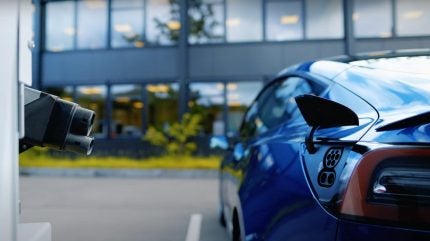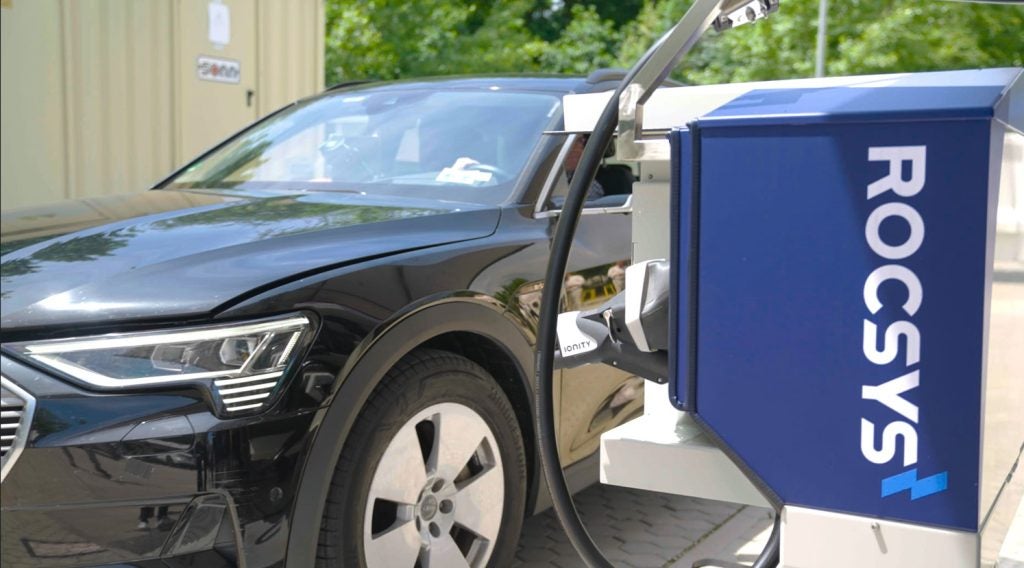
Autonomous driving and robotaxis are continuing to get closer to significant market impact, especially in countries such as the US and China where legislation permits the use of higher levels of vehicular autonomy. However, although these solutions are driverless or require minimum contribution from drivers, the charging of such vehicles is still a manned operation.

Discover B2B Marketing That Performs
Combine business intelligence and editorial excellence to reach engaged professionals across 36 leading media platforms.
Rocsys, a company that manufactures hands-free charging solutions for electric vehicles, has developed a solution called ‘ROC-1’, a robotic arm which fully automates the docking process of the charging connector to an EV. The ROC-1 communicates with the vehicle from starting the charging process to undocking the vehicle when the entire charge cycle is complete. This charging process takes place without human intervention.
We spoke with Crijn Bouman, CEO and founder of Rocsys, to learn more about this robotic solution and to discuss the future of autonomous vehicles and robotaxis.

Just Auto (JA): Could you provide some background on the company?
Crijn Bouman (CB): Rocsys is a company which provides hands-free charging. We do that by means of robotics. The bigger story behind Rocsys is that we are on a mission to accelerate the shift to zero emission and autonomous vehicles. Charging is a major bottleneck to be addressed if you want to scale automated vehicles; we provide the solutions to do that.
I’ve been in the electric mobility industry for about 19 years now. I founded a company called Epyon. We made fast chargers for electric cars and that company was acquired by ABB and became the ABB charging group. I stayed for six years at ABB, and during those years I met with a very secretive company in California, who were developing a robotaxi in a warehouse. We supplied them with chargers, and that sparked the interest for Rocsys.
Could you explain how ROC-1 works?
The current product is called ROC-1. It is designed for automated vehicles and it’s also designed for ports and logistics applications. It’s used with automated vehicles that are also manual driven; sometimes there is a requirement that the driver needs to do the charging because of safety, legislation, or union contracts.
The other application is logistics centers, the big delivery centers where there’s already a significant share of automated vehicles. That’s our first-generation product and we are working on the second generation which is tailored to the robotaxi market.

Could you discuss the ROCIN-ECO consortium?
We are working with a number of automakers: Audi, Mercedes, BMW, Ford and Porsche. In that consortium we have built and written a standard for robotic charging of cars, because there is some standardisation to be done.
It’s about the sequence, because if it needs to work with any car. There needs to be a software communication signal to indicate when the vehicle can be plugged in or out.
When you want to roll this out for the mass market, there need to be common standards. We wrote a standard, and that will be published at the end of 2025, and then from the consortium – at least one, maybe two carmakers – have already agreed that the next generation platform would be compatible with robotic charging.
When you want to roll this out for the mass market, there need to be common standards.
OEM road maps are long, of course. I would say in the period of 2026 to 2029 we may see the first cars on the road compatible for robotic charging, perhaps more focused on the automated parking applications or automated valet parking. It’s not yet a robotaxi, but you step out of your vehicle, and the vehicle will drive itself into a parking location, garage, and that functionality will come from all the premium OEMs toward the end of the decade.
What do you see the future holding for robotaxis?
I’m convinced that within the next two years we will have a ChatGPT ‘wow’ moment for robotaxis. Today Waymo already does 100,000 paid rides per week in their robotaxis.
I was in San Francisco recently and I took six rides, and they were all great – it’s really working. Baidu in China announced that they will be profitable with their robotaxi (which will be in operation next year), which is an amazing feat.
Location-wise it is happening most rapidly in the US and China. The UK might be the next, because there is legislation allowing self-driving vehicles on public roads from 2026 onwards. The UK might be the first in Europe.
You need to get the vehicle to work, you need to have the permits, and then it’s about operational excellence. Getting the vehicle on the road, making sure it’s available, it’s charged, it’s continuously available for riders, that is the business model, and that’s why we are in talks with all the robotaxi companies.
Running the charging operation for robotaxis is it’s a massive operation. After two years of speaking to the robotaxi companies, the general direction is that to operate a robotaxi in a large metropolitan area like London, you would need a couple of people just for managing charging.
Any minute spent in the depot means lost revenue. You need to have the vehicles on the road 24/7, to be available, be visible to consumers, because if it takes 50 minutes for vehicle to arrive, people take an Uber because that’s faster. This is often overlooked because everybody’s focused on the vehicle. The next big thing is, can you make this profitable, and can you compete with the human driver? That’s where the operational excellence comes in. The operation of charging hubs is crucial.
At the moment, the industry produces a nice car, which consumes a massive amount of raw materials. It’s one of the biggest purchases consumers make. Then 95% of the time it’s parked, and the 5% of the time we are actually using it, we are stuck in traffic. There inherent inefficiency in the system, in terms of asset utilisation, so we need to move to a model where car ownership is more shared and smarter. Therefore, making sure that autonomous vehicles succeed is key for us.
I think the changing point is going to be in the next two years when people suddenly appreciate that robotaxis can really work and fit their lifestyles.
What needs to be done to have robotaxis up and running in 2026 in the UK?
It’s make or break. You need to compete with human drivers, and you need to compete against other robotaxi companies and ensure your operation is as efficient as possible. If you remove the driver, but then have 300 people per city to run the charging, it takes away the net benefit.
In the next two decades every vehicle will start to park itself
In the next two decades every vehicle will start to park itself, but at the same time, we are deploying tens of billions of charging infrastructure everywhere, and everything’s been built for manual operation. You need to have a way to upgrade the existing infrastructure to accommodate self-driving vehicles, and that’s also why we took the robotics approach.
You take the cable, which is on the charger, you mount it to a robotic system, and it will automatically connect to a vehicle. You could also retrofit the worldwide installed base of chargers, and not rip them out of the ground and build something new.
That’s why we took the robotics approach. We always said don’t change the vehicle, because making a change to the vehicles is very difficult for the big vehicle OEMs with their four-, five-year roadmaps. We also said don’t change the charging infrastructure, because there’s been massive investment there. If you change the charging infrastructure to a new concept for a lot of the commercial operators, there would not be an incentive to make that change, because they have invested into those assets to pay off for the next ten years, so they will not make the change.
You need to come up with a solution that is retrofittable and creates value for everybody; for the carmakers, the charging infrastructure owners, and that’s how we came to our approach.






